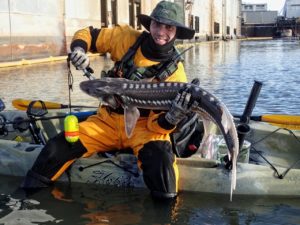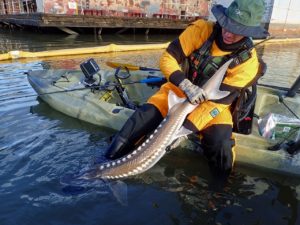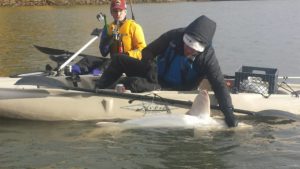Sturgeon 180? I’ll explain…
Dec 11th was the 3rd annual Sturgeon Social on the Willamette River in Portland. Roughly 30 kayak anglers in all the popular manufacturers/models were in the meat line beckoning a sleigh ride. Brad Hole of Kayak Fishing Washington and myself were the only two equipped with Hobie’s new 180 drive. First impression of the drive was solid with a slightly different feel over prior models. Reverse seemed novel at the time, but this opinion would soon change…
Sturgeon can be sizable, and handing them in a shipyard packed with structure was a feat in its own. I witnessed fish after fish lost to floating buoy lines and a partially submerged wall of a massive dry dock. Sturgeon aren’t big fighters like salmon, tuna, or jacks, but they are heavy and built with a broad heterocircle tail keeping the pressure on! The majority of fish were hooked on the edge of the dry dock, and would often run straight underneath. Without the ability to reverse most anglers were at the mercy of the fish. This is where the 180 was worth its weight in safely released dinosaur!
Once the hook was set, I was able to maintain a rod position and line angle optimal to rapidly land and safely release several fish by utilizing the reverse function. Distancing the kayak from obvious structure took only a little forethought and coordination opposed to fighting my boat and the fish in concert. The 180 drive will immediately appeal to bass fishermen and small water anglers for good reason. I learned quickly that it shouldn’t be overlooked by the big game/big water crowd either. The experience has left me brainstorming innovative new ways to utilize this tool.
As for sturgeon fishing itself: Sturgeon are in no way a predator. They have large sucking bucket shaped mouths underneath a long nose. They locate potential food sources via smell, then pinpoint further with barbels under the nose.
The take is very light and subtle, especially for a fish of that size! It’s really just a faint tap’tap. A relatively sensitive rod shows it best, but must also have a stiff backbone to handle/rapidly (as possible) land a fish potentially weighing triple digits. Let me further complicate the situation… Most state fishing regs require a barbless hook. If they don’t, you should use one anyhow to aid in release, but that’s another topic… With that said, a somewhat flexible rod will help maintain a deep bend and keep steady pressure holding the hook solid.
The rig is quite simple. A main line of heavy braid (50lb or higher), enough lead to hold the bottom attached to a slide on your main line, leader of 30lbs or higher at 18-24”, with a 3/0-6/0 hook depending on your bait of choice snelled to the business end. Bait ranges anywhere from night crawlers, to shrimp, squid, herring, or anything between! They’ll often show a preference of one over another, so the successful angler should have a few offerings.
Although large, sturgeon can be quite fragile. Small fish should be properly supported by the base of the tail and near the pectoral fins/front of body for a quick photo. Truly big fish should not be removed from the water. Large fish can be grabbed by the bucket like mouth, and base of the tail. They should not be lifted by the mouth or tail alone though to protect their spine. A quality pair of grips such as Lucid, and/or a dependable partner are helpful in handling fish over 3’. This will also help avoid the sharp bony scutes along the back, belly, and sides.
Sturgeon fishing is a ton of fun, and open year round for C&R with a few short retention season in select areas. If kayak big game fishing appeals to you, this can be a great relatively safe way to cut your teeth or hone your skills. Tight lines, and good luck!






